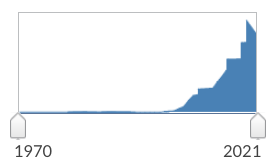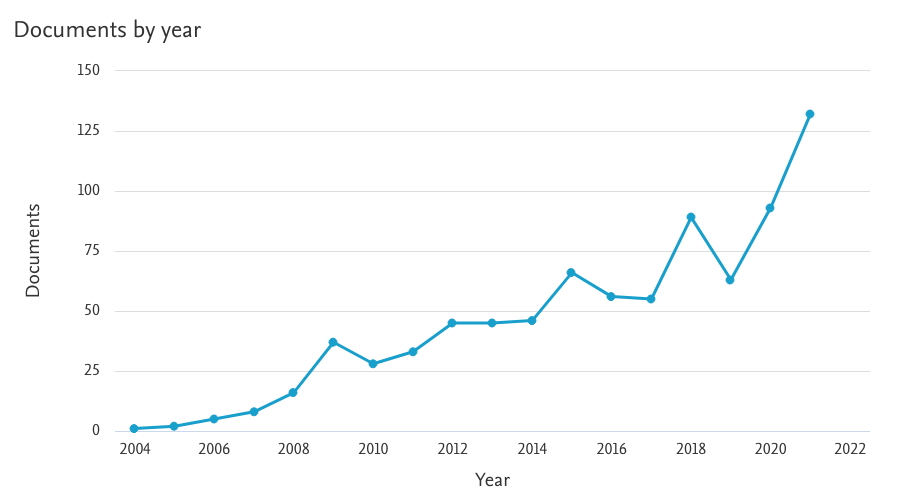
September 16, 2022, by Brigitte Nerlich
Tipping point
Over the past 15 years or so, the use of the term ‘tipping point’ has exploded in the scientific literature. My current interest was sparked by a new paper on tipping points published in Science. The lead author is David Armstrong McKay, a University of Exeter Earth systems scientist, and the paper is an update of a 2008 paper with Timothy Lenton as lead author, also University of Exeter, and co-author on this paper. And while I was writing this post, I discovered that there is/was a global tipping point conference at the University of Exeter!
In the following, I’ll try to trace the concept of ‘tipping point’ from the 1950s to now and how it migrated from the social sciences to the climate sciences and back into the social sciences. This post can only provide some sign-posts though. It builds on much larger research efforts by other scholars, some of which I’ll mention along the way.
A definition
The latest paper on tipping points provoked a little discussion on Twitter during which the climate scientist Michael Mann said that his go-to definition for ‘tipping point’ was that provided by the Oxford English Dictionary, namely: “the point at which a series of small changes or incidents becomes significant enough to cause a larger, more important change.” Ah, I thought, that’s just where I would have started.
The 1950s – the social science of tipping points
The OED gives four examples for uses of the phrase ‘tipping point’. Two relate to research into racial segregation and only one, from 2014, relates to glacier melting. A 1957 article in Scientific American states: “White residents who will tolerate a few Negroes as neighbors..begin to move out when the proportion of Negroes in the neighborhood or apartment building passes a certain critical point. This ‘tip point’ varies from city to city and from neighborhood to neighborhood.” Strange to think that I was one year old when that was written!
The Merriam Webster Dictionary highlights the racist origins of the phrase more strongly. It points out that tipping point had been been used literally and figuratively off and on for quite a long time, but when it “first began to be employed in general use, it was almost entirely in reference to the propensity of white families to move out of an area when a certain percentage of the neighborhood was composed of black families. It served as a precursor of sorts to the phenomenon of white flight.”
In the 1950s and 60s, and for a long time afterwards, the concept of tipping point was used to study critical shifts and changes in social and environmental relations, in the early 2000s even social tipping points in the context of climate change. It was mainly a social science concept. (For a critique of that concept, see now here)
The early 2000s – a bestseller sells the tipping point
Things changed in the year 2000 when Malcolm Gladwell published his book The Tipping Point with a subtitle that echoes the OED definition: How Little Things Can Make a Big Difference. He talked about a tipping point as “that magic moment when an idea, trend, or social behavior crosses a threshold, tips, and spreads like wildfire” or, using a range of other metaphors and similes, such as “the moment of critical mass, the threshold, the boiling point”. He is interested in how social “[i]deas, products, messages and behaviors spread like viruses do”.
This eye-catching use of tipping point and related metaphors made the social science term public and amenable to being used more widely in the natural and social sciences, including climate science, and in the public sphere, including the media. When we look at Scopus, a database of peer-reviewed literature, we see that the term ‘tipping point’ was used rarely in research until about the year 2000, when the Gladwell effect kicked in.
“Tipping point” search on Scopus, 13 September, 2022
The book appeared at the right time. Discussions had gradually started in climate science circles about abrupt changes in the climate system and in 1998 an article in the Atlanta Journal and Constitution notes: “[…] scientists warn that if global warming is truly occurring, the somewhat subtle changes we are seeing today aren’t our real worry. They point out that complex systems such as climate tend to stay relatively stable for a long time, absorbing pressure for change until it reaches a tipping point. Once that point is reached, major change occurs quickly, in a relative snap of the fingers.”
2004 onwards – between science and politics
When I searched Scopus for ‘tipping point’ AND ‘global warming’ OR ‘climate change’, I found that the first academic article using the phrase was was from 2004, namely an article by the environmental sociologist John Urry on the car industry, which uses insights from complexity theory, such as path dependency. This sociological article was followed by an environmental science article in 20o5 by Jonathan Foley entitled “Tipping points in the tundra”. Many more followed.
“Tipping point” AND “global warming” OR “climate change” search on Scopus, 13 September, 2022
A similar graph emerges when one searches for ‘tipping point’ on Nexis, the news database, where the rise of the phrase also starts around 2004/2005:
“Tipping point” search on Nexis (up to 31/12/2021), 13 September, 2022
This was the time when tipping points became political and public. In 2004 the Pentagon in the United States published a report (written in 2003) entitled An Abrupt Climate Change Scenario and Its Implications for United States National Security. It does not mention the term ‘tipping point’, but warns about the possibility that global warming is not gradual and could, instead, lead to abrupt changes that politicians need to know about.
2004 was also the year that the film The Day After Tomorrow was released dealing with catastrophic climate change and stimulating public discussion. An article published in 2004 (in In These Times) says about the film: “Yes, the movie is hyperbolic but not entirely off the mark. Contrary to conventional wisdom, global warming could well make its presence felt suddenly and catastrophically, unless humans do something about climate change soon.”
The article also tells the story of Richard Allen, who collected ice cores in Greenland, and quotes him as saying: “’What we know is that there are threshold points, there are flipping points, in the Earth’s climate,’ he said. Alley provided this analogy: ‘If you sit in a canoe and you lean a little bit, not much happens, and you lean a little more and not much happens, and you lean a little — and you’re in the water.’”
It was intriguing to see the term ‘flipping point’ as a synonym for tipping point and also the use of a seesaw analogy. The same analogy was visually used in an ‘explainer’ of the 2022 article on tipping points, illustrated with a seesaw on which we see how the earth roles down one side of the balance and tips it. It would be really interesting to find out how tipping points have been imagined and visualised over time, through such symbolic or analogical imagery or through images of melting glaciers or vanishing coral reefs.
In 2005 the American Meteorological Society asked: “Thinning arctic sea ice: Have we passed a tipping point?” The article points out that “The large changes that began in 1989 suggest that the system had reached a tipping point, a state of the system for which temporary changes in the external forcing (dynamics) created a large internal response that is no longer directly dependent on the external forcing and that is not easily reversed.” We are getting increasingly more scientific in the tipping point discourse.
The same year, the famous climate scientist James Hansen, who had put climate change on the political map at the end of the 1980s. gave a talk at the American Geophysical Union and “warned that ‘we are on the precipice of climate system tipping points beyond which there is no redemption'”. This reminded me of course of the famous mixed metaphor uttered by a climate change expert in 2006: “We are standing on the precipice of a runaway train”.
In 2006 Gabrielle Walker wrote an article entitled, playfully: “Climate change: The tipping point of the iceberg” in which she said: “The idea that passing some hidden threshold will drastically worsen man-made climate change has been around for decades, normally couched in technical terms such as ‘nonlinearity’, ‘positive feedback’ and ‘hysteresis’. Now it has gained new prominence under a new name”. This indicates that the term was imported from the social sciences and used to convey rather difficult scientific terms already in use to discuss the phenomenon of ‘tipping points’. She also says that “[t]he idea is spreading like a contagion”.
We can see a convergence of the social science term ‘tipping point’ with concepts from systems and complexity theory.
2008 onwards – between science and communication
Another important point in the course of the development of the tipping point discourse, apart from the years 2000 and 2004 was the year 2008, when Tim Lenton, et al. published their article “Tipping elements in the Earth’s climate system” in the Proceedings of the National Academy of Sciences. As they say, the term ‘tipping point’ “commonly refers to a critical threshold at which a tiny perturbation can qualitatively alter the state or development of a system.”
As pointed out by CarbonBrief, in the autumn of 2008 the American Geophysical Union “had an entire half-day session dedicated to climate tipping points. A Science briefing about the meeting declared that ‘tipping points, once considered too alarmist for proper scientific circles, have entered the climate change mainstream’.” Nowadays, the word ‘doomist’ has replaced the word ‘alarmist’ in some circles.
At that time, people interested in climate change communication started to scrutinise the term tipping point. In 2008 Chris Russill published a seminal article on tipping point discourses in which he pointed out that “[p]rominent British and American sources now seek to structure public understanding of climate change by issuing ‘tipping point’ forewarnings of danger with increasing frequency”.
Tipping point had become not only a term used for making scientific statements, but for making people do things. It had gained performative force. This performative potential was viewed critically by some who thought that tipping point warnings may induce fear and inaction rather than action – debates about this are ongoing.
In 2009 Chris Russill and Zoe Nyssa published another important article on the tipping point trend in climate change communication, followed by Sandra van der Hel, Iina Hellsten and Gerard Steen’s article on tipping point metaphors in 2018.
Another article, from 2016, by Egbert van Nes et al., charts the fate of the tipping point concept in the context of ecology and notes the convergence of the term with concepts from mathematics and systems theory/chaos/catastrophe/complexity theory: “Over time the term finally linked up with mathematical theories related to catastrophe theory. The most common specification of the term is its use as a synonym for the mathematical concept of a catastrophic bifurcation […]. In these cases, the tipping point corresponds to a critical level of an external condition (e.g., nutrient inflow of a lake) where a system shifts to an alternative state.”
They go on to point out a shift in that meaning: “other authors have narrowed the definition down in different ways. For instance, in recent papers published in Trends in Ecology and Evolution, tipping points represent ‘unstable equilibrium states, which are the peaks of the potential landscape’. Therefore, we propose that the term ‘tipping point’ should simply be used for any situation where accelerating change caused by a positive feedback drives the system to a new state.”
These new framings of tipping point by mathematical theories would deserve further research, in terms of which aspects of these theories are used and what metaphors and images they conjure up, from landscapes, especially hills, to the snapping of an elastic band, to seesaws, to tipping chairs.
Tim Lenton, whom we encountered in 2008, says in 2022, that he “likes to think of tipping points like someone leaning back on a folding chair. ‘When you start tipping over backwards you have in that case a very simple kind of feedback on the forces of gravity operating on propelling you backwards until SPLAT'”, while his colleague Johan Rockström, “director of the Potsdam Institute for Climate Impact Research in Germany, likened it to someone lighting a fuse on a bomb ‘and then the fuse will burn up until the big bang and the big bang may be further down the line.'” In an earlier book he had also used the proverb ‘The straw that broke the camel’s back’ which, unlike tipping point, focuses on irreversible collapse (reversibility or not is a whole other story….)….
2022 – a tipping point in tipping point studies?
That brings us to 2022 and the article by McKay et al. (including Lenton and Rockström), a follow-up or update on the 2008 article that sparked a lot of discussion. The title of the article talks about multiple tipping points and in the ‘rationale’ they say: “Recent work has suggested that up to 15 tipping elements are now active“. That was a new conceptual of tipping point to me, as I thought of tipping points mostly in the singular.
The first ‘abstract’ of the article entitled, rather playfully, “Getting tipsy” says: “Climate tipping points are conditions beyond which changes in a part of the climate system become self-perpetuating. These changes may lead to abrupt, irreversible, and dangerous impacts with serious implications for humanity.”
Some might call this ‘doomism’, but there is hope, as discussed at a recent conference on tipping points held at the University of Exeter. There is interesting stuff to be found under the hashtag ‘tipping points’ (or #tippingpoints2022), including the speech by Tim Lenton using tipping point as a metaphor when he says, I paraphrase, that he hopes to build a “tipping point alliance” of tipping point thinkers and doers, triggering tipping points in the understanding of tipping point risks and opportunities, and stimulating positive tipping points of action! He also mentions ‘positive social tipping points’ in an article in The Guardian.
There seems to be a whole new research agenda on ‘positive’ tipping point and the acceleration of social change, as explored, for example by Lenton in a recent article entitled “Operationalising positive tipping points towards global sustainability”….. (he also talked about ‘virtuous tipping points’ in 2013).
So, we have come a long way from the social sciences studying quite negative social tipping points in racially segregated neighbourhoods to both the natural and social sciences searching for positive social tipping points as potential remedies for climate change dangers. Can one call this a tipping point in the study of tipping points?
PS: 20 November 2022. For the first time ever, the word ‘tipping point’ has been mentioned in a COP cover decision text – COP27
Image: Seesaw Pixabay
No comments yet, fill out a comment to be the first



Leave a Reply